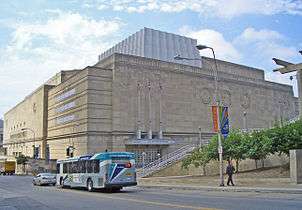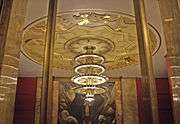Municipal Auditorium (Kansas City, Missouri)
 | |
| Location |
301 West 13th Street, Kansas City, Missouri |
|---|---|
| Coordinates | 39°05′54″N 94°35′11″W / 39.098353°N 94.586416°WCoordinates: 39°05′54″N 94°35′11″W / 39.098353°N 94.586416°W |
| Owner | City of Kansas City, Missouri |
| Operator | Kansas City, Missouri Convention and Entertainment Facilities |
| Capacity | Arena: 7,300 permanent +2,687 temporary[1] |
| Construction | |
| Opened | 1935 |
| Renovated | 2007, 2013 |
| Construction cost |
$6.5 million ($112 million in 2016 dollars[2]) |
| Architect |
Gentry, Voskamp & Neville Hoit, Price & Barnes |
| Tenants | |
|
Kansas City Kings (NBA) (1972–1974, 1979–1980) UMKC Kangaroos (NCAA) (1986–2010, 2013–present) Kansas City Attack (NPSL) (1991–1992) Kansas City Roller Warriors (WFTDA) (2009–present) | |
Municipal Auditorium is a multi-purpose facility located in Kansas City, Missouri. It opened in 1936 and features Streamline Moderne and Art Deco architecture and architectural details.
Background
Municipal Auditorium was the first building built as part of the "Ten-Year Plan", a bond program that passed by a 4 to 1 margin in 1931. The campaign was run by the Civic Improvement Committee chaired by Conrad H. Mann. Other buildings in the plan included the Kansas City City Hall and the Kansas City branch of the Jackson County Courthouse. The plan was championed by most local politicians including Thomas Pendergast and provided Pendergast with many patronage opportunities during the Great Depression.[3]
Municipal Auditorium replaced Convention Hall which was directly across the street and was torn down for parking in what is now called the Barney Allis Plaza.
The streamline moderne architecture was designed by the lead architectural firm of Alonzo H. Gentry, Voskamp & Neville. Gentry later completed the design of the Harry S. Truman Presidential Library and Museum after the death of the original architect, Edward F. Neild. Homer F. Neville was the lead designer for Municipal Auditorium.[3]
Hoit, Price & Barnes, the associated architects were responsible for the design of the mechanical work (HVAC, electrical, plumbing). William L. Cassell directed that design effort.[4] Cassell went on to start his own firm in 1933 which is still in business as W. L. Cassell & Associates, Inc.[5]
Henry F. McElroy, the choice of Tom Pendergast and other Democratic leaders to be City Manager,[6] announced on January 5, 1932, that the architectural services for Municipal Auditorium would be divided between the firm of Gentry, Voskamp & Neville and the firm of Hoit, Price & Barnes.[4] In addition, Gentry's firm would take the lead. The decision was controversial and led to lengthy contract negotiations. Gentry's firm was much smaller, while Hoit, Price & Barnes were known for their work in designing the Kansas City Power and Light Building, an Art Deco skyscraper completed in 1931; the 32-story Fidelity Bank Building at 909 Walnut; Corinthian Hall; and many more Kansas City buildings and residences. Municipal Auditorium, however, was a public project and Gentry, whose father had been a prominent Democratic politician in Independence, was the preference of the Pendergast machine. Fortunately, according to Neville, there was little interference with the building's design.[3]
When the building opened in 1935, the Architectural Record called it "one of the 10 best buildings of the world that year".[7] In 2000, the Princeton Architectural Press called it one of the 500 most important architectural works in the United States.[8]
Municipal Auditorium is connected to the H. Roe Bartle Convention Center via skywalks over 13th and Central streets. An underground walkway through a public parking garage provides access to the Kansas City Marriott Downtown, Holiday Inn Aladdin Hotel, and the Folly Theater.
.png)
Arena
The Arena, nicknamed "Municipal", has hosted the Mid-America Intercollegiate Athletics Association tournament annually, each March since 2003. When Kansas City hosts the Big 12 Conference tournament, women's games take place here. It is currently home to the NAIA Men's Division I Basketball National Tournament. It was played here from 1937–1975, when it moved into Kemper Arena, and has been home since the Tournament moved back to Kansas City from Tulsa in 2002.
The arena hosted three of the first four Final Fours, but has not hosted an NCAA tournament game since 1964.[9] In 2013, the University of Dayton Arena passed Municipal Auditorium in number of games hosted as that arena hosts the opening round games of the NCAA tournament.
The 19,500-seat Kemper Arena was built in 1974 to accommodate Kansas City's professional basketball teams that had been playing at the Auditorium. The Kansas City Kings (known at the time as the Kansas City-Omaha Kings) played their first two seasons at the Auditorium, then returned for the majority of the 1979–80 season after the roof of Kemper Arena caved in on June 4, 1979.
On November 13, 1979, Darryl Dawkins of the Philadelphia 76ers completely shattered backboard during a game vs. the Kings with a thunderous slam dunk.
It is home to the University of Missouri–Kansas City Kangaroos basketball team. Since January 2009, it has been the home of the Kansas City Roller Warriors roller derby league.[10]
The 2013 $5 million renovation included new video boards, LED scorer's table, sound system, lighting, electrical upgrades, and lower level seating.[1]
Music Hall
The Kansas City Music Hall is a large proscenium theatre with a striking Streamline Modern interior that seats an audience of 2,400 patrons. The hall presents touring Broadway shows, as well as visiting symphony orchestras, opera and ballet companies, and other events. It was the main hall of the Kansas City Philharmonic for several decades. It's also the home of the 1927 Robert-Morton Theatre Pipe Organ that originally was in the Midland Theatre. The organ is owned and maintained by Kansas City Theatre Pipe Organ, Inc.[11]
Little Theatre
The Little Theatre is an elegant octagonal ballroom with a capacity for 400, or banquet seating for 225 available for catered events, and a private balcony room for up to 36 guests.
Gallery
 An example of the Art Deco details found throughout Municipal Auditorium.
An example of the Art Deco details found throughout Municipal Auditorium. Foyer of
Foyer of
Little Theatre. Art deco chandelier in Music Hall.
Art deco chandelier in Music Hall. Wall decoration in
Wall decoration in
Little Theatre. Monumental Art Deco medallion on the front of Municipal Auditorium.
Monumental Art Deco medallion on the front of Municipal Auditorium.
Sports succession history
| Events and tenants | ||
|---|---|---|
| Preceded by Cincinnati Gardens |
Home of the Kansas City-Omaha Kings (with Omaha Civic Auditorium) 1972 – 1974 |
Succeeded by Kemper Arena |
| Preceded by Patten Gymnasium Hec Edmundson Pavilion McGaw Hall Cow Palace Freedom Hall |
NCAA Men's Division I Basketball Tournament Finals Venue 1940 – 42 1953 – 55 1957 1961 1964 |
Succeeded by Madison Square Garden McGaw Hall Freedom Hall Freedom Hall Memorial Coliseum |
References
- 1 2 "Municipal Auditorium". University of Missouri–Kansas City.
- ↑ Federal Reserve Bank of Minneapolis Community Development Project. "Consumer Price Index (estimate) 1800–". Federal Reserve Bank of Minneapolis. Retrieved October 21, 2016.
- 1 2 3 Gray, Meghan L. (2013). Forgotten Landmark: The Municipal Auditorium of Kansas City, Missouri (M. Arts thesis). University of Missouri-Kansas City. (subscription required (help)).
- 1 2 Mitchell, Giles Carroll (1934). There is No Limit: Architecture and Sculpture in Kansas City. Brown-White Company, Kansas City.
- ↑ "W. L. Cassell & Associates, Mechanical and Electrical Engineers" (PDF). Retrieved 25 January 2016.
- ↑ Reddig, William M. (1947). Tom's Town, Kansas City and the Pendergast Legend. J. B. Lippincott Company. ISBN 978-0826204981. (subscription required (help)).
- ↑ "Alonzo H. Gentry, Architect, Is Dead". Kansas City Times. February 7, 1967.
- ↑ Kidder, G.E. Smith (June 1, 2000). Source Book of American Architecture. New York City: Princeton Architectural Press. p. 381. ISBN 978-1568980249. (subscription required (help)).
- ↑ Official 2007 NCAA Men's Final Four Records Book (PDF). NCAA. January 2007. p. 114. Retrieved 2016-02-02.
- ↑ Packham, Chris (January 22, 2009). "Blood on the Rink". The Pitch.
- ↑ "The Star of Our Show". Kansas City Pipe Organ, Inc. Retrieved 2016-02-02.